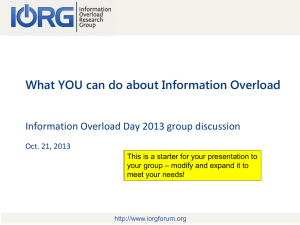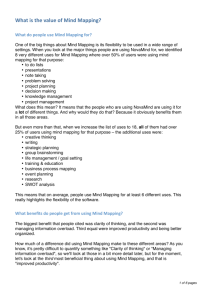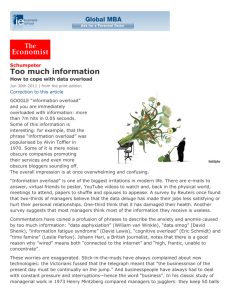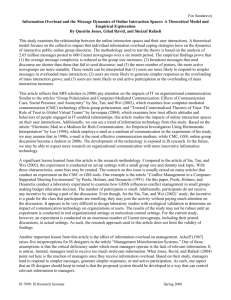Dealing with Information Overload
advertisement
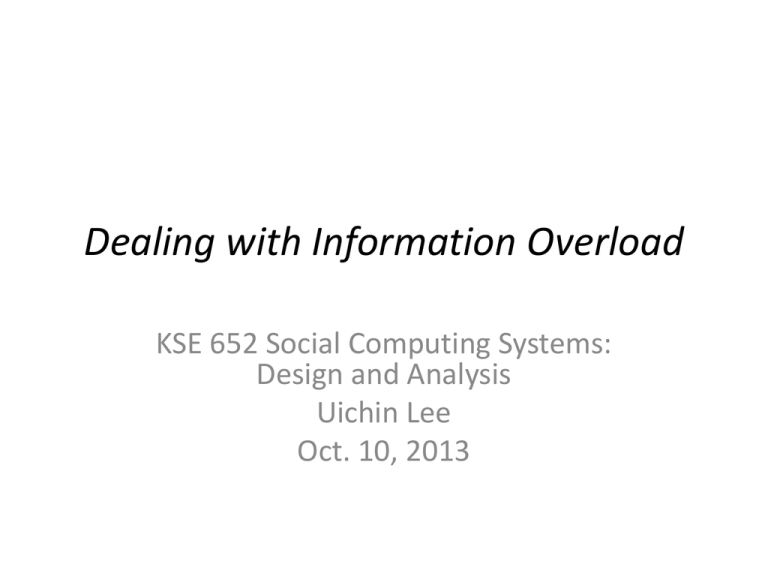
Dealing with Information Overload KSE 652 Social Computing Systems: Design and Analysis Uichin Lee Oct. 10, 2013 Cognitive Overload • Humans can only undertake a finite amount of informationprocessing tasks during a given period of time • Cognitive overload happens due to multi-tasking, interruption, and information overload • Cognitive overload linked to: – Too much info supply? (oversupply of push/pull info) – Too much info demand? (too complex desire of info due to uncertainty; e.g., filing, piling, learning, etc.) – The need to deal with multi-tasking and interruption – The inadequate tool support to help reduce metacognition (mental effort of controlling one's cognitive processes) A few thoughts on cognitive overload, David Kirsh, Intellectica 2000 Interactions in Social Systems • Types of interactions – – – – One-way (broadcasting); e.g., TV, radio style Two-way/non-interactive: messages flow bilaterally Reactive: later messages refer to one’s immediately preceding them Responsive/interactive: later messages refers a series of preceding ones • Chat room example w/ two users: A and B – Two-way/non-interactive: typing with no coherence/ack – Reactive: B types in a response to a message posted by A – Responsive/interactive : A B; feedback that relates both to previous messages and to the way previous messages related to those preceding them Networked interactivity, S. Rafaeli and F. Sudweeks, JCMC 1997 Interaction Space (Virtual Public) • Processing load relates to a number of factors – Rate, message size (frequency/density) – Threaded interactions (consistency) – Interactional coherence (diversity/entropy, disruption) • Beyond a threshold load, stress zone is encountered, making unsustainable interactions • How do people deal with information overload? – – – – Increasing efforts (say for a short period) Learning new information management tools (if available) Producing simpler responses, delaying till time allows Ending participation (disengagement) User Population and User Contributions to Virtual Publics, Quentin Jones, Sheizaf Rafaeli. In GROUP'99 User-Population/Contribution Model • Critical mass has to be reached for group interaction to be sustained • An increase in user population will not result in an equal increase in interaction volume • Individual cognitive-processing limits produce a constraint to volume User-Population/Contribution Model Group chatting News Group (Communication density of a user; e.g., # messages per user) Empirical Evidence of Info Overload (IRC Chatting Dataset) Typical IRC User Interface (MIRC) Yahoo Chat User Interface Empirical evidence of information overload constraining chat channel community interactions, Quentin Jones, Mihai Moldovan, Daphne Raban, Brian Butler, CSCW 2008 Message density = # messages / # users Message density Empirical Evidence of Info Overload (IRC Chatting Dataset) Total # of users (max) in a chat room Empirical Evidence of Info Overload (IRC Chatting Dataset) density = # messages / # posters posters/users ratio: constant 14 posters/users ratio: keep decreasing Dealing with Info Overload • Dormitory example – Clustering residents in short hallways (w/ 20 people or less) were found to be less stressful • Residents knew more of their neighbors – Vs. long hallways: unwanted interaction; lack of protective group structure • Structural design aspects of interaction space – Structuring social interaction to make a densely occupied space feel more like a set of small communities • S/W tools – – – – – Automatic classification (or routing) Filtering and scanning Summarization Cost-based interaction intervention (e.g., to prevent junks) Moderation tools Structuring computer-mediated communication systems to avoid information overload, Starr R. Hiltz, Murray Turoff, CACM Volume 28 Issue 7, 680-689, July 1985 Dealing with Info Overload • Real problem is understanding group objectives and providing tools that allow individuals/groups to structure their own communications • Any process that limits overload by structuring content will also destroy potential benefits • Tools for limiting overload should be based on structuring processes and should allow individuals to control content Structuring computer-mediated communication systems to avoid information overload, Starr R. Hiltz, Murray Turoff, CACM Volume 28 Issue 7, 680-689, July 1985
